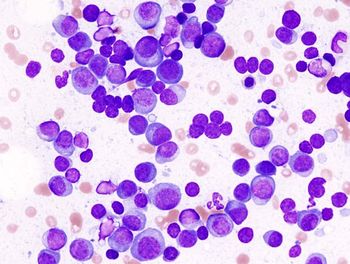
Oncology NEWS International
- Oncology NEWS International Vol 7 No 7
- Volume 7
- Issue 7
Cardiotoxicity with Combination Doxorubicin/Paclitaxel (AT) Is Reversible, Rare With 6 Cycles
MILAN, Italy--The cardiotoxicity seen in preliminary studies of bolus doxorubicin (Adriamycin) plus 3-hour paclitaxel (Taxol) (AT) proved to be reversible and mostly confined to patients who received more than 6 cycles of therapy, according to follow-up data presented at the ASCO meeting.
MILAN, Italy--The cardiotoxicity seen in preliminary studies of bolus doxorubicin (Adriamycin) plus 3-hour paclitaxel (Taxol) (AT) proved to be reversible and mostly confined to patients who received more than 6 cycles of therapy, according to follow-up data presented at the ASCO meeting.
"These follow-up data indicate that effects on myocardial contractility are reversible after the end of AT and confirm that limiting the total dose of doxorubicin to 360 mg/m² (6 cycles of AT) significantly decreases the risk of congestive heart failure," Pinuccia Valagussa, of the Istituto Nazionale Tumori, Milan, reported at a poster session.
Of the 49 women with metastatic breast carcinoma enrolled in the study, 48 were continuously followed for a median of 42 months (range, 7 to 54 months). The AT regimen was planned for 8 cycles in the first 25 women (to a maximum doxorubicin dose of 480 mg/m²) and for 6 cycles in the last 24 patients (to a maximum doxorubicin dose of 360 mg/m²). Thirty-six women received additional paclitaxel alone (175 to 200 mg/m²) for a median of 5 cycles.
High Response Rate
Response rate was 94%, including 18 complete responses (38%) and 26 partial responses (55%) in the 47 evaluable patients.
Echographic monitoring of heart contractility showed a decrease of left ventricular ejection fraction (LVEF) from baseline of 59% to 51% after completion of therapy (P < .001). The decrease was statistically significant in patients receiving 8 cycles of AT but not in those receiving 6 cycles.
Improvement of LVEF was observed after the end of therapy, and LVEF after a median of 24 months (58%) was similar to that before AT (59%) in 25 evaluable patients.
Seven women (14%) developed congestive heart failure (CHF) within 12 months from the start of AT (median, 8 months). Six were in the group receiving 8 cycles (24.6%) and only one in the group receiving 6 cycles of AT (4.6%).
"LVEF measured before CHF never decreased more than 11% and did not predict for subsequent CHF," Ms. Valagussa said. "All patients who developed CHF responded to diuretics and digoxin, and none died of CHF."
Ms. Valagussa said that after a median follow-up of 42 months, the data indicate good long-term therapeutic activity of AT in patients previously untreated with chemotherapy, with 38% of patients still alive, 9 progression-free, and 5 in continuous unmaintained remission.
"The antitumor activity and cardiac safety profile for doses of AT up to 360 mg/m² of doxorubicin justify the conduct of ongoing adjuvant/neoadjuvant studies of the combination," she concluded.
Articles in this issue
over 27 years ago
Calling the National Cancer Instituteover 27 years ago
Six Cycles of AT Found Safe in Advanced Breast Cancerover 27 years ago
New Drug Promising in Advanced Pancreatic Cancerover 27 years ago
Herceptin/Chemo Effective in Metastatic Breast Cancerover 27 years ago
Virtual Reality Exhibit Simulates Cancer Fatigueover 27 years ago
New Director of AIDS Researchover 27 years ago
Exhibit Explores Healing Power of Creating Artworkover 27 years ago
Update on Trials of Thrombopoietin for Platelet Recoveryover 27 years ago
Amifostine Reduces Xerostomia After RT for Head and Neck Cancerover 27 years ago
National Survey Documents Gap in Quality of HIV/AIDS CareNewsletter
Stay up to date on recent advances in the multidisciplinary approach to cancer.

















































































